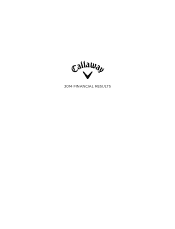Callaway 2014 Annual Report Download - page 19
Download and view the complete annual report
Please find page 19 of the 2014 Callaway annual report below. You can navigate through the pages in the report by either clicking on the pages listed below, or by using the keyword search tool below to find specific information within the annual report.3
At December 31, 2014 and 2013, most of the Company’s golf club production volume was made in regions outside of
the United States. Overall, the golf club assembly process is fairly labor intensive and requires extensive global supply chain
coordination and utilizes raw materials that are obtained from suppliers both internationally and within the United States.
In February 2013, the Company sold the building housing its golf ball manufacturing operations in Chicopee,
Massachusetts and leased back a reduced portion of the square footage to better align with current manufacturing volumes.
In addition, the Company utilizes golf ball contract manufacturers in China and Taiwan. During each of 2014 and 2013,
approximately 60% of the golf ball production volume was manufactured in regions outside of the United States. The overall
golf ball manufacturing process utilizes raw materials that are obtained from suppliers both internationally and within the
United States and, although a significant amount of labor is used, is much more automated than the golf club assembly process.
The Company has its primary distribution center in Dallas, Texas for the distribution of goods in North America, a
distribution center in Melbourne, Australia and third-party logistical operations in Tokyo, Japan, London, England, Shanghai,
China, and Seoul, Korea to support the distribution needs of those markets.
Raw Materials
The Company purchases raw materials from domestic and international suppliers in order to meet scheduled production
needs. Raw materials include steel, titanium alloys and carbon fiber for the manufacturing of golf clubs, and synthetic rubber,
thermoplastics, zinc stearate, zinc oxide and lime stone for the manufacturing of golf balls. For certain risks associated with
golf club and golf ball manufacturing, see “Risk Factors” contained in Item 1A.
Sales and Marketing
Sales in the United States
Of the Company’s total net sales, approximately 48% was derived from sales to customers within the United States in
each of 2014 and 2013, and approximately 47% in 2012. The Company primarily sells to both on- and off-course golf retailers
and sporting goods retailers who sell quality golf products and provide a level of customer service appropriate for the sale of
such products. The Company also sells certain products to mass merchants. Sales of the Company’s products in the United
States are made and supported by full-time regional field representatives and in-house sales and customer service
representatives. Most regions in the United States are covered by both a field representative and a dedicated in-house sales
representative who work together to initiate and maintain relationships with customers through frequent telephone calls and
in-person visits.
In addition, other dedicated sales representatives provide service to corporate customers who want their corporate logo
imprinted on the Company’s golf balls, putters or golf bags. The Company imprints the logos on the majority of these corporate
products, thereby retaining control over the quality of the process and final product. The Company also pays a commission
to certain on- and off-course professionals and retailers with whom it has a relationship for corporate sales that originate
through such professionals and retailers.
The Company also has a separate team of club fitting specialists who focus on the Company’s custom club sales. A
portion of the Company’s custom club sales are generated from the utilization of club fitting programs such as performance
centers, which utilize high-speed cameras and precision software to capture relevant swing data. All performance centers and
participating on-and-off course retail stores are equipped with custom fitting systems that incorporate the use of an extensive
variety of clubhead and shaft combinations in order to find a set of golf clubs that fits a golfer’s personal specifications. The
Company believes that offering golfers the opportunity to increase performance with custom club specifications increases
sales and promotes brand loyalty.
The Company maintains various sales programs including a Preferred Retailer Program. The Preferred Retailer Program
offers longer payment terms during the initial sell-in period, as well as potential rebates and discounts for participating retailers
in exchange for providing certain benefits to the Company, including the maintenance of agreed upon inventory levels, prime
product placement and retailer staff training.
Sales Outside of the United States
Of the Company’s total net sales, approximately 52% was derived from sales for distribution outside of the United States
in each of 2014 and 2013, and approximately 53% in 2012. The Company does business (either directly or through its
subsidiaries and distributors) in over 100 countries around the world.
























